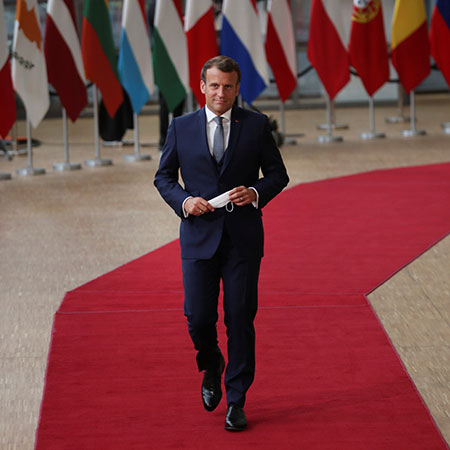investment insights
EU recovery package adds firepower to economic arsenal


Lombard Odier Private Bank
Key takeaways
- The EU summit deal’s EUR 750 billion pandemic fund represents a significant advance in the bloc’s economic development
- The package equates to more than 5% of the EU’s GDP
- We maintain our 1.17 target for the EURUSD by year-end and see upside risks
- We keep our preference for more defensive US stocks compared with European names.
Three days into the European Union summit talks last week and facing an impasse, German Chancellor Angela Merkel and French President Emmanuel Macron got up and walked out. Behind their Covid-19 facemasks the message was clear; the Franco-German alliance that in mid-May prepared a pandemic rescue plan was determined to get a deal and avoid a two-speed European economic recovery. The resulting compromise may prove the two leaders’ most enduring European legacy.
After five days of negotiations, the eventual 21 July deal, worth EUR 750 billion in grants and loans, demonstrates an EU-wide willingness to coordinate a response to the Covid-19 crisis. It also adds an important tool to the EU’s arsenal for coping with economic emergencies. For the first time, the bloc’s executive, the European Commission, will be able to shoulder debt on behalf of the 27 member states. In addition to the headline-grabbing recovery package, the EU’s leaders also agreed the bloc’s common seven-year budget, worth EUR 1.1 trillion, and the first since the UK’s departure.
Low-interest loans
Last week’s package comes in addition to measures already implemented at a national level and is worth more than 5% of the EU’s total Gross Domestic Product (see chart). It may raise support for the Italian economy, for example, to around 30% of national GDP. While it is too soon to interpret the deal as the start of fiscal coordination or risk sharing in the EU, as it does not enshrine the grants and loans in the bloc’s annual budget, it does set a precedent for cooperation over emergency spending.
Starting next year, the Commission can take on low-interest debt, backed by the European Central Bank, worth EUR 360 billion on financial markets, with maturities through 2058. The deal also offers grants worth another EUR 390 billion. The grants will not add to the debt burden of member states because they will be offered at a European rather than national level.
Remarkably, the agreement took only two months to pull off. In comparison with the speed that a single nation such as the US or Japan can act, that of course looks slow. But the deal overturns some entrenched attitudes, in particular Germany’s historic aversion to debt and a reluctance by a number of northern nations to lend to their southern neighbours. Overall, it reinforces the EU’s ability to stand on its own feet.
A good, not great deal
This “Next Generation EU” (NGEU) fund offers, in the best traditions of the bloc’s negotiations, wide-ranging compromise. France and Germany overcame objections to grants from a group labelled the ‘frugal four’ (Sweden, Denmark, and Austria along with Dutch Prime Minister Mark Rutte, their de facto leader), with pledges for eventual political oversight of the spending, and postponed legal checks that the governments of Poland and Hungary contested.
Therefore, while the deal demonstrates a renewed strength and confidence, some of the compromises store up challenges for the future. Firstly, the ‘frugal four’ lowered the original Franco-German proposal for EUR 500 billion in grants by sacrificing some spending on healthcare and dropping a link between funds and a climate change target: Poland remains the only EU member state that has not backed a commitment to a carbon-neutral economy by 2050. Nevertheless, 30% of the combined EUR 1.8 trillion recovery fund and seven-year budget is aimed at meeting the EU’s net zero carbon goal.
Secondly, the recovery deal provides extra budget rebates to the frugal four, which will inevitably create future frictions. Thirdly, a source of tension will be any oversight of the spending. The summit postponed attempts to link grants to respect for the EU’s rule of law. The governments of both Poland and Hungary are under scrutiny by the European Commission over their respect for democratic values.
Adjusting exposure
Markets interpreted the summit deal positively. The euro gained against the dollar, reaching a 20-month high and ten-year German sovereign debt fell as low as -0.5%.
We maintain our target of 1.17 for the euro-US dollar (EURUSD) by the end of the year, and see risks to the upside. Aside from the much-needed financing support that the deal provides member states, the agreement marks an historic shift in EU fiscal management in times of crisis and so removes much of the ‘break up’ or ‘redenomination’ risk to the single currency. As a result, it should act as a catalyst to attract flows to the euro area, pushing EURUSD higher.
For our equity exposure, we adjusted our portfolios to a neutral positioning on European stocks in late April and reduced that allocation further to underweight in mid-May, preferring US names. This reflects our preference for exposure to companies with defensive growth characteristics that make up a greater share of US markets. Overall, for now, we continue to believe that the US economy offers greater growth prospects and US stocks offer a more convincing earnings outlook and more robust profitability.
Wichtige Hinweise.
Die vorliegende Marketingmitteilung wurde von der Bank Lombard Odier & Co AG oder einer Geschäftseinheit der Gruppe (nachstehend “Lombard Odier”) herausgegeben. Sie ist weder für die Abgabe, Veröffentlichung oder Verwendung in Rechtsordnungen bestimmt, in denen eine solche Abgabe, Veröffentlichung oder Verwendung rechtswidrig wäre, noch richtet sie sich an Personen oder Rechtsstrukturen, an die eine entsprechende Abgabe rechtswidrig wäre.
Entdecken Sie mehr.





teilen.